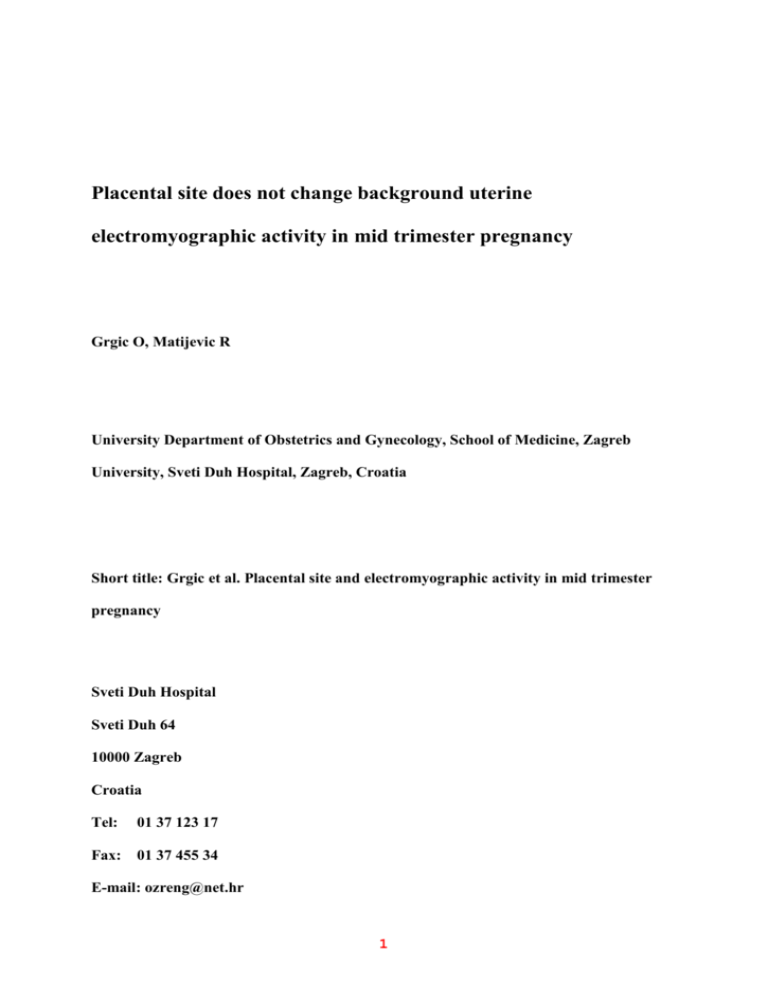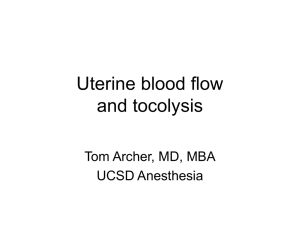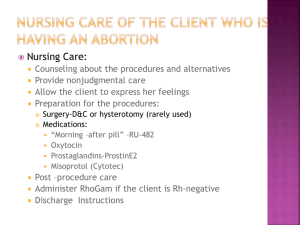Placental site does not change electromyographic activity in mid
advertisement

Placental site does not change background uterine electromyographic activity in mid trimester pregnancy Grgic O, Matijevic R University Department of Obstetrics and Gynecology, School of Medicine, Zagreb University, Sveti Duh Hospital, Zagreb, Croatia Short title: Grgic et al. Placental site and electromyographic activity in mid trimester pregnancy Sveti Duh Hospital Sveti Duh 64 10000 Zagreb Croatia Tel: 01 37 123 17 Fax: 01 37 455 34 E-mail: ozreng@net.hr 1 Abstract Aim: This study is performed in order to assess the changes of electromyographic (EMG) activity of the uterus above the placental implantation site in mid trimester pregnancy. Methods: In this prospective study 156 unselected, nulliparous asymptomatic women with singleton pregnancy underwent transabdominal uterine electromyography. Uterine electrical activity was recorded using bipolar electrodes placed on the abdominal surface for 20 minutes. Outcome measures were: number of action potentials (AP), median frequency (MF) and median amplitude (MA) of AP regarding to the placental implantation site. Results: Among 156 recruited pregnant women the placenta was positioned anteriorly in 90 women (anterior placenta group- APG) and posteriorly in 66 women (posterior placenta group- PPG). AP are detected at 42 women (APG 28/90 versus PPG 14/66). This difference was not statistically significant (p= 0.167, Student t - test). The other analyzed parameters: MF (left and right uterine side) and MA (left and right uterine side) did not show any statistical significant difference between two groups. Conclusion: Placental site does not change background uterine electromyographic activity in mid trimester pregnancy. Key words: transabdominal electromyography - EMG, placenta, implantation site, uterine electrical activity, action potentials, mid pregnancy 2 Introduction Uterine electrical activity is an important subject of interest in the last several decades, particularly after development of a new, noninvasive method for the electrical assessment of the pregnant uterus - transabdominal uterine electromyography (EMG) and improved filtering system that reducing the recording artifacts [1, 2]. Such electrical activity originates form the depolarization and repolarisation of thousands of smooth muscle myometrial cells [3]. Like any, myometrial cells have two forms of electric potentials: resting membrane potential and action potential [4]. Myometrial cells communicate though gap junctions and its development plays an important role in the electrical evolution of the myometrium [5, 6]. Action potentials have ability to spread unchanged trough gap junctions from one to another myometrial cell, causing increased and organized electric activity [7]. Organized and synchronized electric activity precedes mechanical activity resulting in myometrial contractions [1, 8], and together with cervical maturation is related to the initiation of labor [1, 9]. The uterine electrical activity, measured from the abdominal surface, can be detected from 16 – 18 weeks of pregnancy and, the anterior uterine wall is the main origin of the uterine electrical activity detected trough the abdominal wall [1, 2]. Some investigators reported that anterior placental implantation site changes the electrical activity of the human uterus during pregnancy and labor, measured from the abdominal surface [9 -12]. This phenomenon is based on the local hormonal inhibitory influence of the placenta on the surrounding myometrial cells [10, 11]. The aim of this study is to test the influence of the placental implantation site on the electrical uterine activity measured from the abdominal surface (transabdominal EMG) in low risk asymptomatic population of pregnant women in mid trimester of pregnancy. 3 Materials and methods This is a prospective study performed between October 2002 and September 2003 at University Department of Obstetric and Gynecology, “Sveti Duh” Hospital, Zagreb, Croatia. Totally,156 unselected, Caucasian, asymptomatic women with singleton pregnancy underwent transabdominal uterine EMG. This investigation was a part of screening project performed in order to detect potential risk group for preterm labor and late spontaneous miscarriage (Croatian Ministry of Science, Project No 0129111). The entry criteria were: 1.nulliparous women with singleton pregnancies 16 0/7 – 23 6/7 gestational weeks, 2. asymptomatic pregnancy without clinical and laboratory evidence of infection (WCC < 14 x 1012/l, CRP < 10 mg/dl, no evidence of infection on cervical and vaginal swabs). The exclusion criteria were all one that can change EMG activity and they are presented on table 1. Prior to entry to the study, every woman signed informed consent form approved by hospital and national ethical committee. Placental implantation site was determined by transabdominal ultrasound scan (Aloka 5500, ALOKA CO. LTD, Japan) and before the EMG was performed every woman had empty urinary bladder. Uterine EMG activity was detected using the two bipolar surface silver-silver chloride disc electrodes (The 2-channel TECA™ Synergy T-EP system, Oxford Instruments). The electrode sites of attachment were cleaned with fine abrasive paper and treated with the electrode gel. They were applied to abdominal wall by the adhesive tape halfway between the uterine fundus and symphisis and the interelectrode distance was approximately 6 cm. The reference electrode was placed on the woman’s right wrist. Every measurement lasted for 20 minutes. The EMG activity was amplified, acquired and digitized using TECA™ Synergy, EMG LivePlayTM software. The data were filtered in the 0.1-4 Hz frequency range and the sampling frequency was set at 20 Hz. The analyzed EMG parameters were: number, median 4 frequency (MF) and median amplitude (MA) of the recorded action potentials (AP) from the left and right side of the uterus. All women had follow up appointment 7 days. The results were known to principal investigators only (OG and RM) and the course of pregnancy was unaltered based on the obtained results. For statistical analysis of the maternal age, gestational time at the examination, body mass index, number of AP we used a Student t - test for independent variable (SPSS v13.0, SPSS Inc., Chicago IL). Because the data of frequency and amplitude of AP were skewed, range and median values are reported. Comparison of median values was made with the Mann – Whitney U test (SPSS v13.0, SPSS Inc., Chicago IL). P < 0.05 was considered to be statistically significant. 5 Results Among 156 recruited pregnant women the placenta was positioned anteriorly in 90 women (anterior placenta group- APG) and posteriorly in 66 women (posterior placenta group- PPG). The median time of examiation was 20.1 weeks (APG 19.9+2.3 versus PPG 20.2+2.1 weeks), ranging 16 0/7 – 23 6/7 weeks. This difference was not statisticaly sugnificant (p= 0.301, Student t-test). The average body mass index (BMI) was 22.8 kg/m2 (APG 23+0.5 kg/m2 versus PPG 22.7+0.7 kg/m2, p=0.471, Student t-test). The comparison between groups is presented in table 2. AP are detected at the 42 patients (APG 28/90 versus PPG 14/66). This difference was not statistically significant (p= 0.167, Student t - test). The other analyzed parameters: MF (left and right uterine side) and MA (left and right uterine side) did not show any statistical significant difference between two groups. 6 Discussion In this study we analyzed the EMG activity in low risk population of pregnant women in mid trimester of pregnancy. This technique is simple, providing ethically acceptable method for better understanding of uterine physiology. From the second trimester, the uterus by its size is large enough for transabdominal measurement. As there is a still an open question about artifacts resulting from muscle activity of the abdominal wall and internal organs we opted for a MF measurements. MF was considered to be a better assessment parameter, as it is not so dependent on the type and quality of the tissue [10]. The anterior uterine wall is the major origin of the EMG activity detected trough the abdominal wall [10, 11]. In pregnant women with no contractions EMG activity represents the background uterine electrical activity [1, 11]. In some studies it was reported that anterior placental implantation could reduce the EMG uterine activity due to the placental hormonal inhibitory influence on the surrounding myometrial cells [10, 11]. Because of that the transabdominal EMG detect only the background uterine EMG activity [10, 11]. Several decades ago, Jung tested the electrical activity of the uterus above the placental implantational site. He was unable to detect electrical activity if the electrode was placed above the placental implantational site [12]. Marque et al, found a difference in the EMG activity during the labor between patients regarding anterior or posterior placental insertion, pointing that local placental hormones could decrease the EMG activity [11]. Gondry et al, monitored 8 patients, 4 with anterior and 4 with posterior placental insertion, and found no significant difference in the recorded EMG activity between the two groups [9]. Kavsek et al did not found significant difference in the EMG activity of the uterus in patients without contraction, regarding the placental implantation. However, comparing women with contractions they found a significant difference in the EMG activity in women with anterior 7 compared to posterior placental implantation. The patients with anterior placental implantational site had lower RMS value and higher MF value [10]. In our study we found that placental implantation site alone does not change the uterine EMG activity in asymptomatic women, registered trough the abdominal wall in mid trimester of pregnancy. This actually supports the theory that in the presence of contractions, particularly during labor, hormonal changes in the placenta influence electrical activity of myometrial cells above the placental implantation site. This theory has been proven by other authors [10, 11]. As none of our investigated pregnant women have contractions during examination neither without next 7 days of follow up and as there was no difference in MF and MA value; it can be suspected that uterine contractions may be responsible for hormonal inhibitory influence of the placenta on the surrounding myometrial cells. This observation may have implications for understanding of uterine physiology in pregnancy, and can be used in designing study protocols for further investigation. Therefore in this process of screening of asymptomatic women in order to detect potential “risk” group for preterm labor and late miscarriage, if transabdominal EMG is used placental site should be of no importance. 8 References 1. Devedeux D, Marque C, Mansour S, Germain G, Duchene J. Uterine electromyography: a critical review. Am J Obstet Gynecol 1993;169:1636-1653. 2. Buhimschi C, Boyle MB, Garfield RE. Electrical activity of the human uterus during pregnancy as recorded from the abdominal surface. Obstet Gynecol 1997;90:102-111. 3. Csapo AI. Smooth muscle as a contractile unit. Physol Rev 1962;42:7-15 4. Kumar D, Barnes C. Studies in human myometrium during pregnancy. Resting membrane potential and comparative electrolyte level. Am J Obstet Gynecol 1961;82:736-741. 5. Miller SM, Garfield RE, Daniel EE. Improved propagation in myometrium associated with gap junctions during parturition. Am J Physiol 1989;256:130-141. 6. Garfield RE, Sims SM, Daniel EE. Gap junctions: their presence and necessity in myometrium during parturition. Science 1977;198:958-960. 7. Sims SM, Daniel EE, Garfield RE. Improved electrical coupling in uterine smooth muscle is associated with increased numbers of gap junctions at parturition. J Gen Physiol 1982;80:353-375. 8. Shafik A. Electrohysterogram: study of the electromechanical activity of the uterus in humans. Eur J Obstet Gynecol Reprod Biol 1997;73:85-89. 9. Gondry J, Marque C, Duchene J, Cabrol D. Electrohysterography during pregnancy: preliminary report. Biomed Instrum Technol 1993;27(4):318-324. 10. Kavsek G, Pajntar M, Leskosek B. Electromyographic activity of the uterus above the placental implantation site. Gynecol Obstet Invest 1999;48(2):81-84. 11. Marque C, Duchene JM, Leclercq S, Panczer GS, Chaumont J. Uterine EHG processing for obstetrical monitoring. IEEE Trans Biomed Eng 1986;33(12):11821187. 9 12. Jung H. Hormonal control of the conduction of impulses in the myometrium. J Obstet Gynaecol Br Emp. 1962;69:1040-1041. 10 Table 1 The factors that could change EMG activity Uterine Extra uterine Uterine abnormalities Medication (tocolytic or 1.Müllerian tract spasmolitic agents) abnormalities 2. Endocervical or endometrial polyps 3. Fibromas Infection (cervical or Overweight* intrauterine) BMI > 25 kg/m2 Contractions Multiple pregnancy Polyhidramnios Abbreviations: BMI – body mass index * - Increased abdominal thickness reduces the sensitivity of the surface electrodes 11 Table 2 Comparison of groups Anterior placenta group Posterior placenta group p Number Age (years)* Time of examination (weeks)* BMI (kg/m2)* Presence of AP* MF on the left side (Hz)** MF on the right side (Hz)** 90 66 29.1+4.7 28.5+4.9 19.9+2.3 20.2+2.1 23+0.5 28/90 0.11+ 0.016 0.11+ 0.008 22.7+0.7 14/66 0.083+ 0.013 0.11+ 0.013 .471 .167 .227 MA on the left side (mV)** 1250+ 500 1000+ 400 .673 MA on the right side (mV)** 1250+ 500 1250+ 500 .578 .574 .301 .191 Abbreviations: BMI – body mass index, AP – action potentials, MF – median frequency, MA – median amplitude * Numbers are: arithmetic mean + standard deviation. Statistical significance was obtained by Student t-test for given variable (double tailed p value) ** Numbers are: median + range. Statistical significance was obtained by Mann – Whitney U test for given variable 12 13








